Moor's Head of Europe
"Moor's heads" refer to the heraldic images of the heads of Africans represented on coats of arms, crests and flags found throughout Europe (1300s AD - present). Despite the common misconception that Moor's heads are representations of unknown Muslims defeated in battle, evidence suggests most known Moor's heads are representations of specific Africans in honor of their contributions to Catholics in Europe.
Austria
Abfaltersbach
The coat of arms of Abfaltersbach, a small town in the southern Austrian alps, dates to 1984 as bestowed by the Tyrol County government. The use of a Moor's head is attributable to Abfaltersbach's geographic position within the historic Prince-Bishopric of Freising, which was established in 1294 AD, and within the larger Diocese of Freising, which was established in 739 AD (see Freising, Germany description below). More specifically, Abfaltersbach's Moor's head was borrowed from the Freising Moor portrayal in the Abbey of Innichen, Italy, which was once included in both the Freising diocese and Tyrol County.


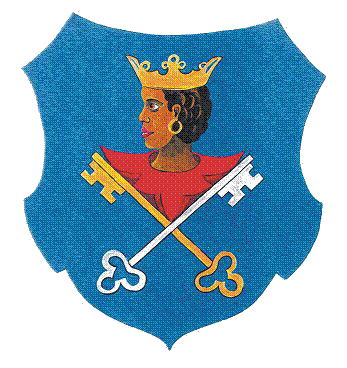 |
Sankt Peter am Kammersberg
The typically crowned Freising Moor is depicted, as Sankt Peter am Kammersberg was a borough of the Freising district until 1803 (See the Freising, Germany description below).
Belgium
Boezinge
 |
 Linkebeek
LinkebeekThe coat of arms of Linkebeek features 3 "wreathed" Moor's heads in a manner similar to that of nearby town, Lennik.


Lennik
According to town history, the coat of arms is descended from 1683 Gaasbeek family crest, which in 1691 changed to the seal of Corneille de Man (shown at right)
Waregem
According to town history the present coat of arms was adopted in the 1970's after the merger of several smaller municipalities. Unusually depicted with a green buttoned shirt with arms crossed behind, it is similar to the coat of arms adopted in the 1890s that was based on the family crests used since 1584 by the Flemish Van Plothos of Ingelmunster near Waregem. The original, however, was Balthasar Edler von Plotho's family crest, which was conceived circa 1470 AD (shown below). The Von Plotho family of Brandenburg, which owned vast regions in the Holy Roman Empire, was first documented by Otto I in 946 AD. Since St. Maurice was patron saint of the Holy Roman Empire, and since the nearby Cathedral of Magdeburg was dedicated to St. Maurice, the Von Plotho Moor is likely a representation of him.
 |
France
Corsica
The modern Corsican Moor's head has been whitewashed with European features and today, many believe that the head is but a mere silhouette of a European man. Contrary to such claims, the Bastia Museum houses the original Corsican Moor's head (as shown below) which has undeniably black features. Some Corsican legends tell that the head was a trophy of a defeated Saracen chief, or that it was the head of a slave. Nonetheless, the positive portrayal, pearls around the moor's neck, and feminine qualities refute such legends.
 |
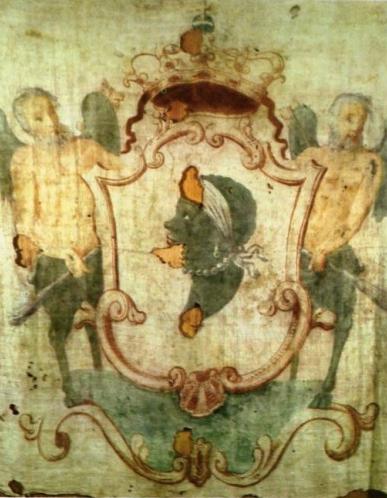 |
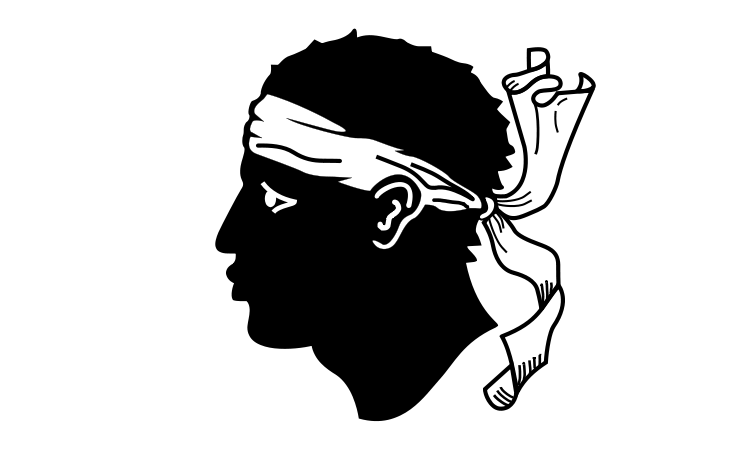 |

Veigy Foncenex
Germany
Coburg
Coburg, the ancestral home of the British royal family Saxe Coburg-Gotha (otherwise known as Windsor), is known for its picturesque castles and museums, but its most popular resident is the Coburg Moor, which appears on the town's edifices, coat of arms, and flag (as shown below). As previously mentioned, the town's history tells that this was the Catholic church's patron saint from Waset (Thebes or Luxor), St. Maurice. Therefore, according to both the town's history and the Catholic church, for which he is a patron saint, Maurice was an Egyptian.




Eisenberg
Freising
The home town of Pope Benedict is adorned with a crowned-head Moor known simply as the "Freising Moor" which may be seen at the Freising castle and on the coat of arms and flags of nearly 20 municipal coats of arms throughout Germany. Pope Benedict used a similar representation of the Freising Moor on his official papal coat of arms, the use of which can be traced to Bishop Emicho of Wittelsbach in Skofja Loka, Slovenia, which was also in the historic Diocese of Freising circa 1316 AD (as shown below). While various Catholic historians have told of Abraham of Freising's encounter with a bear, how his African servant defeated it, the consistent portrayal of the Freising Moor with a crown cast doubt on such story. Other historians suggest it could be a representation of St. Maurice, who was the patron saint of the Holy Roman Empire, or St. Zeno, another canonized African.




Archdiocese of Munich
Italy

Pucci Family
Sardinia
According to the Sardinian government, the flag became associated with Sardinia in the 1300s when the island became part of the Confederation of the Crown of Aragon. However, in the Armorial Gelre (c. 1370), which lists flags and coats of arms of territories throughout Europe, the Moor's heads superimposed by the red cross of St. George are assigned to Sardinia, not Aragon. Sardinia became associated with this flag ever since the reign of Peter III of Aragon (1276-1285 AD), and Peter's sons, Alphonso III (1261-1290 AD) and James II (1267-1327 AD). In 1297 AD, James was crowned King of Sardinia, and various versions of his seal have continuously been associated with Sardinia's flag until the present day. Note that the Sardinian Moors did not originally have white bands, but we see that by 1559, red head bands had been added, as shown by the Kingdom of Sardinia's flag in the depiction of Charles V's funeral procession.
One theory suggests the Moors are representations of St. Maurice, since: (1) the Kingdom of Sardinia was essentially formed in 1238 AD when Holy Roman Emperor Frederick II bestowed Enzo with the title of King of Sardinia (although Barisone was named King of Sardinia from 1164 to 1165 AD), (2) St. Maurice was the patron saint of the Holy Roman Empire, and (3) Sardinia was later ruled by the House of Savoy, which traces its origins to Magdeburg, Germany.
However, depictions of dark-skinned men who are supposed to be St. Maurice holding shields and flags bearing the cross of St. George appear elsewhere in Europe, including at the Weiner Neustadt Abbey (c. 1447 AD) in Germany and House of the Blackheads in Riga, Latvia (c. 1580 AD) as shown below. Like these examples, it is also likely that the Sardinian Moor's heads represent St. George.
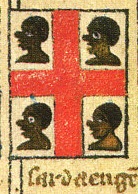 |
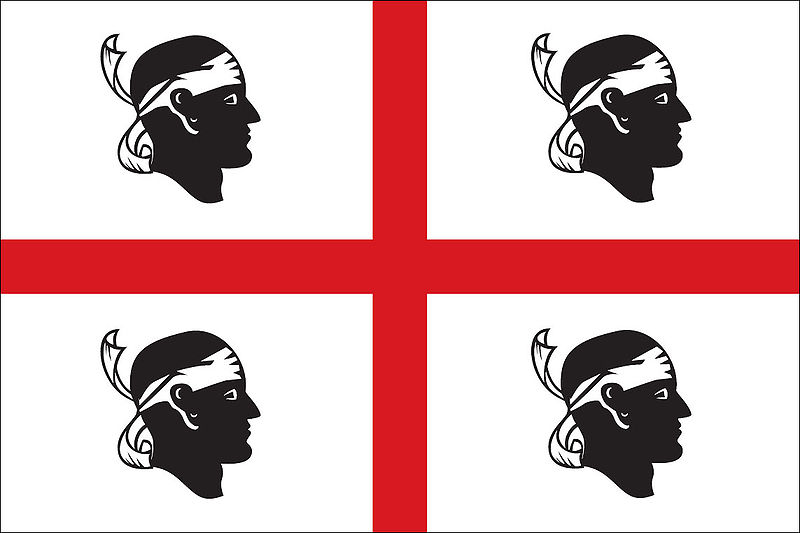 |
 |
Latvia
Riga
 Riga's most famous building, the House of the Blackheads, prominently features an armored Moor (supposedly St. Maurice, c. 1580 AD) with a
cross of St. George below a representation of his head. The building was originally constructed in the late 1300s AD by the Brotherhood of the Blackheads,
an organization formed to defend Reval (Tallinn, Estonia) during the St. George's Day Uprising circa 1343 AD. Therefore the Moor is likely
a representation of one of the most venerated knights of Europe, St. George.
Riga's most famous building, the House of the Blackheads, prominently features an armored Moor (supposedly St. Maurice, c. 1580 AD) with a
cross of St. George below a representation of his head. The building was originally constructed in the late 1300s AD by the Brotherhood of the Blackheads,
an organization formed to defend Reval (Tallinn, Estonia) during the St. George's Day Uprising circa 1343 AD. Therefore the Moor is likely
a representation of one of the most venerated knights of Europe, St. George.
 Slovenia
SloveniaSkofja Loka
The crowned Moor represented on this 1000-year old town's coat of arms and flag is directly related to the aforementioned Freising moor. The town is located in territory granted to Bishop Abraham of Freising in 973 AD.
Spain
Aragon
According to Aragon's official history, the current coat of arms is an assemblage of flags from territories under the former Crown of Aragon and the heads on the coat of arms represent Moors who were defeated at Alcoraz by Pedro I in 1096. However, in the Armorial Gelre (c. 1370), a book that lists flags and coats of countries, Aragon city's coat of arms was represented by the blue flag with the white cross as shown below (the Kingdom of Aragon's is represented by the red and yellow stripes topped with the armored helmet), but the Moor's heads are attributed to Sardinia's flag, not necessarily the Moors defeated by Pedro I at Alcoraz (see the Sardinia description above).
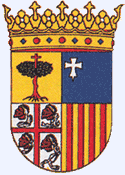 |
 |
 Switzerland
SwitzerlandAvenches
 Cornol
Cornol Flumenthal
FlumenthalContinue >>
